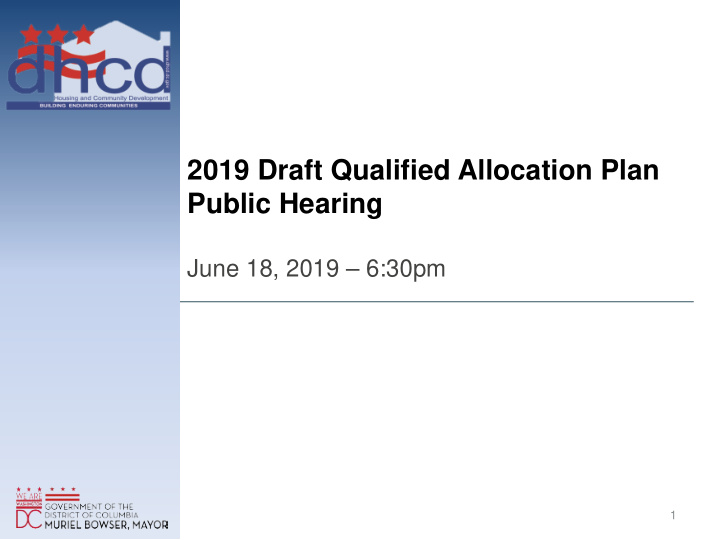



2019 Draft Qualified Allocation Plan Public Hearing June 18, 2019 – 6:30pm 1
Agenda • Overview of Low Income Housing Tax Credits (LIHTC) and the Qualified Allocation Plan (QAP) • Summary of proposed revisions to the 2019 QAP • Opportunity for public comment and testimony 2
Low Income Housing Tax Credit (LIHTC) • Federal tax credit to encourage the private sector to invest in housing that is affordable to households at or below 60% of the Median Family Income (MFI) • Developers sell the tax credits for equity investments in affordable housing projects • Two types of LIHTC – 9% competitive tax credit – 4% non-competitive tax credit that must be used in conjunction with tax-exempt bonds 3
Qualified Allocation Plan (QAP) Overview • DHCD is responsible for administering the LIHTC program on behalf of the District of Columbia • The QAP is the District’s federally-mandated plan for the allocation of tax credits allotted to the District of Columbia by the federal LIHTC program – Governs residential rental housing financed by LIHTC in conjunction with private lenders, tax-exempt bonds, and local and/or federal loan programs – Based on federally mandated requirements and District priority needs – Applicable to both the allocation of competitive 9% LIHTC and the administration of the 4% LIHTC 4
QAP Overview (continued) • Projects must meet all Threshold Eligibility Requirements outlined in the QAP, and clarified in the most recent Affordable Housing RFP – Project Criteria – Financial Criteria – Applicant Criteria – Reports & Plans – Compliance Criteria – LIHTC-Specific Requirements • 9% LIHTC applications are competitively scored – Underwriting Scoring – Prioritization Scoring 5
Proposed Revisions: Threshold Requirements 6
Proposed Revisions: Threshold Requirements • Project Criteria – Basic Eligibility: Income Averaging added as a third minimum set-aside option • Requires 40% of the units in a project to be rent- and income-restricted to households with incomes no greater than 80% AMGI, as long as the average across the project does not exceed 60% AMGI. – Permanent Supportive Housing (PSH): Applicants to sign a certification acknowledging the number of PSH units proposed, and the requirements for providing PSH units. – Renamed Zoning category to “Entitlements and Development Review” 7
Proposed Revisions: Threshold (continued) • Reports and Plans – Market Demand Analysis moved from Underwriting Scoring Criteria to Threshold Eligibility Requirement • Compliance Criteria – Green Design and Building: Projects must either include solar panels, qualify as a Solar Ready Building, or provide an explanation as to why neither option is currently feasible – Community Engagement Plan: Applicants must include a description of efforts to engage the local community and the current residents (if applicable) prior to application, as well as provide an engagement plan following selection 8
Proposed Revisions: Selection Criteria • Development Team Capacity and Experience – Added an analysis of the development team’s past performance. Existing projects will be critically evaluated with consideration for any legal or non-compliance matters. • Compliance with Cost and Funding Guidelines – Added a category for soft costs 9
Proposed Revisions: Selection Criteria 10
Proposed Revisions: Selection Criteria • Demographic Criteria – Senior/Accessible/Artist Housing • Points awarded for projects where at least 30% of the units meet Type A accessibility requirements. Type A units are adaptable to allow seniors to age in place and to accommodate others with mobility issues. • Location Criteria – Points are available for projects located in Opportunity Zones – Economic Opportunity Targeting areas have been updated, taking into account recent data on housing costs and planned residential developments 11
Proposed Revisions: Selection Criteria (continued) • Maximizing Impact of DHCD Resources – Green Building: Now includes Net-Zero Certified or Passive House in addition to the Living Building Challenge; and DOE Zero Energy Ready Home and HERS index scores 12
QAP Update: Schedule Timeline Milestone March 7, 2019 Q&A on the QAP March – May 2019 2019 QAP Drafted June 3, 2019 Draft 2019 QAP is released for public comment period June 18, 2019 Public hearing Friday, June 21, 2019 End of public comment period at 3:30pm Friday, June 28, 2019 Final 2019 QAP published 13
Thank you To submit written feedback: QAP.input@dc.gov 14
Recommend
More recommend